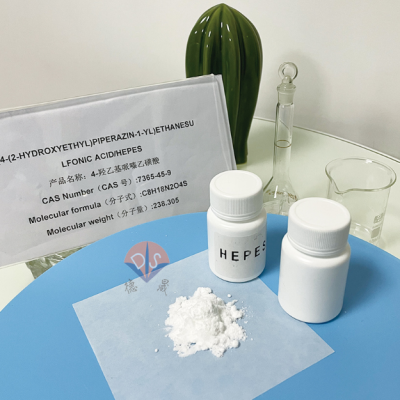Home > Products > Biological buffer > What Does HEPES Buffer 7365-45-9 do for Cell Culture
What Does HEPES Buffer 7365-45-9 do for Cell Culture
500 - 999 Kilograms
1000 - 4999 Kilograms
≥5000 Kilograms
- Shanghai
- T/T L/C PayPal Western Union
- 5 days
You May Like
-
Application of Biological Buffer PIPES 5625-37-6 in Biochemical Research
-
How to Determine and Choose a BES Buffer 10191-18-1 Manufacturer for Procurement
-
Biological Buffer DIPSO (68399-80-4) Detailed Description for Quick Understanding
-
Multiple Applications of CHES Buffer in Biological Research
-
Advantages of High TOOS Molar Absorbance
-
How to Obtain High-quality TOPS Powder as a Chromogenic Substrate
Product Details
| CAS No. | 7365-45-9 |
Product Description
In cell culture experiments, the selection of buffer solution is crucial for the growth, vitality, and experimental results of cells. HEPES (4- (2-hydroxyethyl) -1-piperazine ethanesulfonic acid) is a commonly used cell culture buffer that can stabilize the pH value of the cell culture medium, provide a suitable ionic environment, protect cells from external environmental influences, and thus improve culture efficiency. Let's take a look at the specific role of HEPES buffer in cell culture.
HEPES buffer maintains a stable pH value
1. Sensitivity of cell growth to pH: Cells are highly sensitive to the pH value of their environment during the growth process. A suitable pH range is beneficial for maintaining the normal progress of various biochemical reactions, enzyme activity, and protein structure and function within cells.
2. The pH adjustment ability of HEPES buffer: HEPES (4- (2-hydroxyethyl) -1-piperazine ethanesulfonic acid) has strong buffering ability. It can absorb or release hydrogen ions within a certain pH range, thereby maintaining the pH stability of the cell culture system. During the process of cell culture, the metabolic activity of cells produces acidic or alkaline substances, resulting in changes in the pH value of the culture environment. HEPES buffer can quickly respond to these changes and maintain the pH value of the culture system within an appropriate range through buffering.
Provide a stable ion environment
1. The importance of ion balance for cells: The normal physiological activity of cells depends on a stable ion environment. The difference in ion concentration between inside and outside the cell is crucial for maintaining membrane potential, substance transport, and signal transduction processes.
2. The impact of HEPES buffer on the ionic environment: While maintaining pH stability, HEPES buffer also has a certain influence on the ionic environment of the cell culture system. It can interact with other ions to regulate the concentration and distribution of ions. In addition, the presence of HEPES buffer can reduce ion concentration fluctuations caused by pH changes, providing a more stable ion environment for cells.
Protect cells from external environmental influences
During the process of cell culture, temperature changes can affect the metabolic rate and enzyme activity of cells, while oxidative stress can lead to the accumulation of reactive oxygen species within cells, disrupting their structure and function. HEPES buffer can alleviate the effects of temperature fluctuations and oxidative stress on cells to a certain extent. It can maintain the relative temperature stability of the culture system through buffering, reducing the impact of temperature changes on cells. Meanwhile, HEPES buffer also has certain antioxidant capacity, which can remove some reactive oxygen species in the cell culture system and protect cells from oxidative damage.
Precautions for using HEPES buffer solution
1. Concentration selection: When using HEPES buffer, it is necessary to choose the appropriate concentration based on the specific cell type and culture conditions. Excessive concentration may have an impact on cells, while insufficient concentration may not provide effective buffering.
2. Compatibility with other buffering agents: In some cases, multiple buffering agents may need to be used simultaneously to meet specific experimental requirements. When using HEPES buffer, it is necessary to consider its compatibility with other buffers to avoid interactions that may affect the buffering effect.
3. Storage and usage conditions: HEPES buffer should be stored at appropriate temperature and conditions to avoid being affected by factors such as light, high temperature, and oxidation. When using, dilution and addition should be carried out according to the correct method to ensure the effectiveness of its effects.
HEPES buffer plays an important role in cell culture. It can maintain a stable pH value and ionic environment, protect cells from external environmental influences, and improve the reproducibility of cell culture. HEPES buffer can provide good growth conditions for cells in different types of cell cultures. However, when using HEPES buffer, it is important to choose the appropriate concentration, consider compatibility with other buffers, and adhere to correct storage and usage conditions. By using HEPES buffer reasonably, a more stable and reliable environment can be provided for cell culture experiments.
Hubei Xindesheng Material Technology Co., Ltd., as a manufacturer of HEPES buffer raw materials, has HEPES that is non-toxic to cells, has a wide range of applications, a purity of over 99%, stable processes, and sufficient stock. If you have purchasing intentions, please feel free to click on the website for consultation at any time!
Contact Us

- Hubei New Desheng Material Technology Co., Ltd
- Contact nameDoris Yang Chat Now
Product Categories
| Additive for blood collection | Biological buffer | Chemiluminescence reagent | Chromogenic substrate |
| enzyme preparation |
New Products
-
Stability and Storage Conditions of ADOS Products as Chromogenic Substrates
-
The Simplicity of ADPS Colorimetric Reagent in Experimental Operation
-
Packaging Requirements for Exporting Color Developing Substrate ALPS Powder in Small Batches
-
What Items Can DAOS, a Chromogenic Substrate, be Used to Detect?
-
Basic Information of the New Trinder's Reagent HDAOS Powder Reagent
-
Application of MADB 209518-16-1 in Serum Muscle Enzyme Detection Kit
-
Exploration of the Advantages of MAOS Chromogenic Substrates in Biochemical Detection
-
You Need to Pay Attention to These Three Erroneous Views When Purchasing Carbopol Powder
-
What is the Use of the New Trinder's Reagent TOOS 82692-93-1?
-
Application Introduction of TOPS Color Reagent (CAS40567-80-4)
-
What Applications Can the Chromogenic Substrate ADOS 82692-96-4 be Used In?
-
What Are the Advantages of Using ADPS 82611-88-9 as a Chromogenic Substrate?
-
Application of Color Reagent ALPS 82611-85-6 in Biochemical Experiments
-
Preparation and Use of New Trinder's Reagent DAOS 83777-30-4 Solution
-
Advantages of HDAOS 82692-88-4 as a Chromogenic Substrate in Desheng
-
What is the Function of the Chromogenic Substrate MADB 209518-16-1?
-
What Are the Advantages of the Chromogenic Substrate MAOS (CAS82692-97-5)?
-
The Role of TODB 127544-88-1 in Blood Lipid Testing Kit
-
Desheng Can Supply High-quality Luminol Raw Materials
-
Which is a Good Place to Buy Luminol Monosodium Salt (20666-12-0)
-
Chemiluminescent Reagent Isoluminol Factory Direct Sales
-
Luminescence Analysis of High-purity Acridine Ester NSP-DMAE-NHS 194357-64-7
-
Direct Chemiluminescence of Acridine Ester DMAE-NHS 115853-74-2
-
Detailed Introduction of Luminescent Reagent NSP-SA 211106-69-3
Popular Searches
- sodium hypochlorite
- naclo
- hypochlorite
- calcium hypochlorite
- calcium salt
- potassium butyl xanthate
- calcium sodium
- sodium hypochlorite production
- sodium process
- granule sodium
- sodium hypochlorite water
- sodium 80% powder
- lime plastering
- sodium hypochlorite disinfection
- hypochlorite sodium
- sodium granular powder
- hypochlorite production
- electrolysis sodium hypochlorite
- swimming pool salt
- sea fish aquarium
- of calcium powder
- quotation sample
- aquarium coral
- emamectin benzoate wdg
- calcium price powder
- ptf
- aqua clear
- aquarium for sea water
- aquarium jellyfish
- aquarium white coral
Recommended Products
- Air and Environmental On-Site Testing Items Table
- Water Sample Mercury Ion (Hg²⁺) Concentration Assay Kit
- Nitrite Test Paper 0~100 Ppm
- On Site Rapid Detection of Surface Cleanliness of Catering Utensils
- Sodium Metasilicate Granular 25kg Powder
- Chlorine Dioxide Quick Test Kit
- Residual Chlorine Quick Test Kit
- Rapid Determination of Available Chlorine
- Quaternary Ammonium Sanitizer Concentration Test Strips [0~4000 Ppm]
- Quaternary Ammonium Sanitizer Concentration Test Strips [0~1000 Ppm]
- You Need to Pay Attention to These Three Erroneous Views When Purchasing Carbopol Powder
- Exploration of the Advantages of MAOS Chromogenic Substrates in Biochemical Detection
Find Similar Products By Category
- Chemicals > Chemical Reagent
- Please Enter your Email Address
- Please enter the content for your inquiry.
We will find the most reliable suppliers for you according to your description.
Send Now-
 Doris Yang
Hi there! Welcome to my shop. Let me know if you have any questions.
Doris Yang
Hi there! Welcome to my shop. Let me know if you have any questions.
Your message has exceeded the limit.

- Contact supplier for lowest price
- Customized Request
- Request Sample
- Request Free Catalogs
Your message has exceeded the limit.
-
Purchase Quantity
-
*Sourcing Details
Your inquiry content must be between 10 to 5000 characters.
-
*Email
Please enter Your valid email address.
-
Mobile





